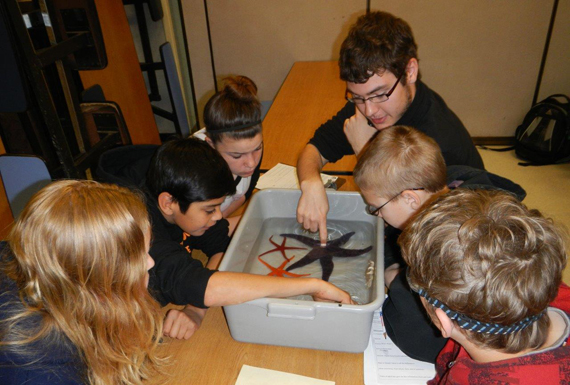Friday Harbor Labs Science Outreach Program
By Jenny Roberts
Friday Harbor Labs (FHL) Science Outreach Program staff are looking forward to their 15th year of engaging local K-12 students from San Juan Island School District and Spring Street International School in scientific processes. This school year we will work with over 700 students and 23 teachers in the classroom, lab, field or onboard the R/V Centennial.
Highlighted below are several exciting projects in which we pair college-level FHL students with students from the Friday Harbor Elementary School (FHES):
 Fig. 1: A first grader works with an FHL Marine Biology student in the Eye Spy Activity.
Fig. 1: A first grader works with an FHL Marine Biology student in the Eye Spy Activity.
Photo credit: Jenny Roberts
Eye Spy Activity: Marine Biology students of Dr. Emily Carrington and Dr. Petra Ditsche work one-on-one with 1st graders to introduce the idea of scientific inquiry/investigation using magnifying loupes to view their world at 5X (Figure 1). With careful and thoughtful observations, the first grade students answer the questions: What does this item remind me of? Why did it remind me of that? Why is it like that? While teaching the first graders the basic science skills of observation and developing hypotheses, this activity is also very rewarding and fun for students both young and old.
Invasive Clam Dig Monitoring Project: Dr. Megan Dethier’s Marine Zoology students work with 3rd graders to conduct an in-field quantitative survey of the invertebrates on Argyle Beach. They are particularly interested in counting the invasive clam Nuttallia obscurata. After their day of digging and sieving, the young students analyze the clam data and compare the results to previous years’ numbers. This is a great experience for them, seeing how scientists collect data and discover the variety of animals that live burrowed in the sand.
Invertebrates & Algae Expert Day: Dr. Drew Harvell’s Marine Biodiversity Apprenticeship students, from Cornell University and studying at FHL, share their marine biology expertise with 6th grade students. FHLSOP staff transport over 100 live organisms to the elementary school, and using these critters the student scientists introduce the younger students to a diversity of invertebrates and kelps/algae found in the Salish Sea (Figure 2). They focus on the variety and uniqueness of nine different groups of organisms. This prepares the sixth graders for their spring field surveys with FHLSOP.
 Fig. 2: Sixth graders learn about sea stars from a Marine Biodiversity Apprenticeship student during "Expert Day."
Fig. 2: Sixth graders learn about sea stars from a Marine Biodiversity Apprenticeship student during "Expert Day."
Photo credit: Jenny Roberts
Rocky Shores Ecosystem Survey: Sixth grade students work in small groups with Dr. Megan Dethier’s Marine Zoology students in the rocky shore habitat to identify organisms during these ecological surveys (Figure 3). They conduct counts and measurements of animals and algae within a square "quadrat" at three different tidal heights with the help of the FHL scientists. Students also complete a scavenger hunt worksheet with questions, observations, descriptions and drawings. This is an empowering experience for both groups of students: the 6th graders relate well to young university students and the university students build confidence by sharing their recently acquired knowledge.
 Fig. 3: Sixth graders collecting data with a Marine Zoology student.
Fig. 3: Sixth graders collecting data with a Marine Zoology student.
Photo credit: Jenny Roberts
This community outreach between the FHL undergraduate courses and the FHES has been a great success. The University instructors have reported that their students count these activities amongst their favorite experiences at FHL.
To learn more about FHLSOP other science projects offered in every grade level, please, see our website at http://depts.washington.edu/fhlk12/
You can support FHLSOP online! Thank you!



